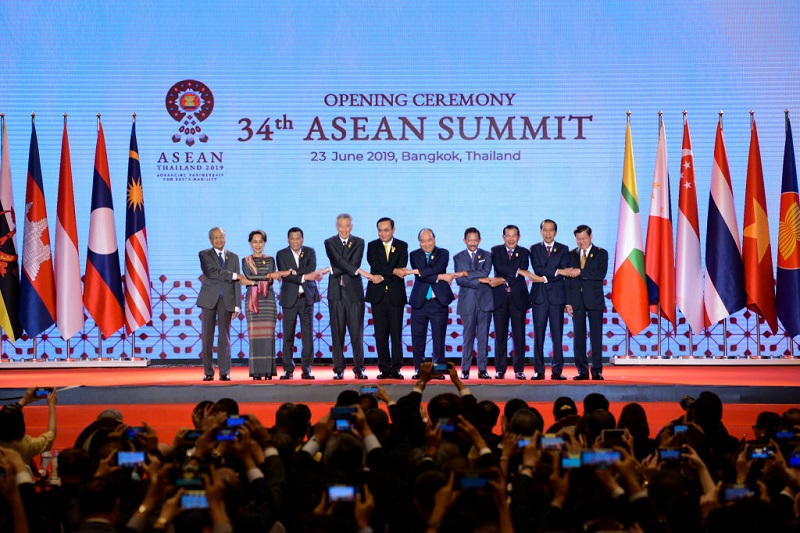
Finally, after much prevarication, pressure and hesitation, ASEAN has decided that it’s time to acknowledge the ‘Indo-Pacific’. At the 34th summit in Bangkok last weekend, ASEAN released its much-anticipated contribution to the Indo-Pacific debate. The ‘
ASEAN outlook on the Indo-Pacific’ paper envisages Southeast Asia playing a ‘central and strategic role’ in connecting the Asia–Pacific and Indian Ocean regions.
Southeast Asia has served as the main venue for articulating and promoting the idea of the ‘free and open Indo-Pacific’ (FOIP) espoused, in one form or another, by the US, Japan, India and Australia. Since the November 2017 APEC Summit in Da Nang where US President Donald Trump
first used the phrase, the FOIP concept—originally advocated by Japanese Prime Minister Shinzo Abe over a decade ago—has had a revival. Numerous speeches have since been made in Singapore (including at the Shangri-La Dialogues in
2018 and
2019), Hanoi, Bangkok, Jakarta and Manila by high-level representatives from the US and Australian governments to actively promote the Indo-Pacific concept and its role in defending a rules-based order.
Three main reasons have been offered for ASEAN’s reluctance to embrace the concept. Across Southeast Asia, there’s been confusion about what the Indo-Pacific strategy actually means. The strategy—or, more precisely, strategies—have not been sufficiently explained and the nomenclature and geographic scope of the ‘Indo-Pacific’ lack clarity. As Singapore’s Foreign Minister Vivian Balakrishnan
observed, ‘We will never sign on to anything unless we know exactly what it means.’ Southeast Asians have been unwilling to refer to the FOIP or to use the term because they haven’t been sure what it entails.
Another explanation for ASEAN’s reticence was the fear of antagonising China. The Indo-Pacific strategy is largely seen as a response by the US and its allies to China’s rise. Southeast Asians complain about the discomfort they feel at the US’s rhetoric on the FOIP, which they associate with forcing the region to choose between the US and China. This (mis)perception has, unfortunately, hindered any deeper appreciation of the tenets underlying the strategy. The Trump administration’s China policy and tariff war have been also (mis)read as revealing the real strategic basis for the Indo-Pacific concept.
The third explanation takes into consideration the very nature of ASEAN. Coordinating any common position among this diverse group of nations takes time. The diversity and granularity of their views of the Indo-Pacific and of the Quadrilateral Security Dialogue are examined in a
recent ASPI report.
Whatever is behind ASEAN’s reticence, the problem with avoiding discussion of the Indo-Pacific is that it undermines ASEAN’s own cherished view of its centrality in regional affairs. Despite having that centrality rhetorically acknowledged by all states that promote the Indo-Pacific concept, ASEAN, by not taking part in this key conversation, has failed, until now, to display that centrality.
Last year,
John Lee argued that the pressure on ASEAN to take a stand on the Indo-Pacific concept was a good thing. It would force the organisation that struggles to achieve any consensus these days to act together and acknowledge the competing visions of the regional order.
As the ASEAN outlook paper was released, many observers were keen to examine it to see just how convergent it would be with the existing versions of the Indo-Pacific concept, particularly the US one. But that question misses the point. ASEAN simply wants to have its own say rather than adopt any of the existing Indo-Pacific proposals.
Indonesia led the efforts for ASEAN to arrive at a common position on the Indo-Pacific. Jakarta hosted a high-level dialogue on Indo-Pacific cooperation in March to which all ASEAN+6 countries were invited. In fact, the idea of the Indo-Pacific treaty of friendship and cooperation—an extension of ASEAN’s Treaty of Amity and Cooperation (TAC), signed in 2013 by ASEAN and its dialogue partners—came from former Indonesia foreign minister Marty Natalegawa.
Back then, the treaty idea didn’t receive sufficient support either domestically or regionally, but it can now serve as a convenient base for the revived concept. The outlook paper presents another opportunity to reinforce ASEAN centrality, its fundamental norms set out in the TAC, and a double-down on the existing ASEAN-led architecture.
The ASEAN paper is an attempt to resolve the dual pressure to accept the FOIP from one side and to reject it from another. The position ASEAN has taken will satisfy no major power as it is neither closely aligned with America’s vision of the Indo-Pacific nor openly contradictory to it.
The paper rejects the notion of the Indo-Pacific as one continuous territorial space. Instead, in ASEAN’s eyes, the Indo-Pacific is made up of two distinct regions: the Asia–Pacific and the Indian Ocean. The view does have commonality with the Japanese vision, which emphasises development and connectivity. The ASEAN statement gives special attention to maritime cooperation, connectivity and infrastructure and other economic cooperation.
The outlook should be seen as a pledge to put ASEAN back in the centre—a plea to ASEAN member states to remain united in order to navigate the increasingly zero-sum dynamics in both the Asia–Pacific and the Indian Ocean. Whether it can be achieved or not, it’s still the best bet for Southeast Asia. The statement is the ASEAN way of counselling the great powers to let the region continue to be an area for economic cooperation and dialogue rather than an arena of competition.
 Print This Post
Print This Post